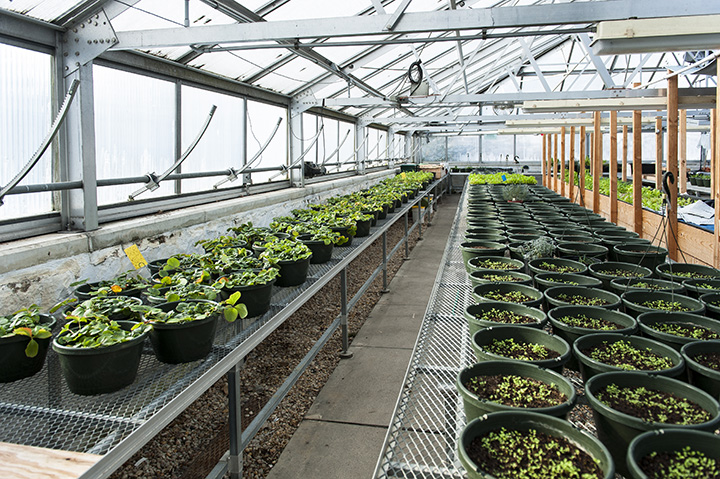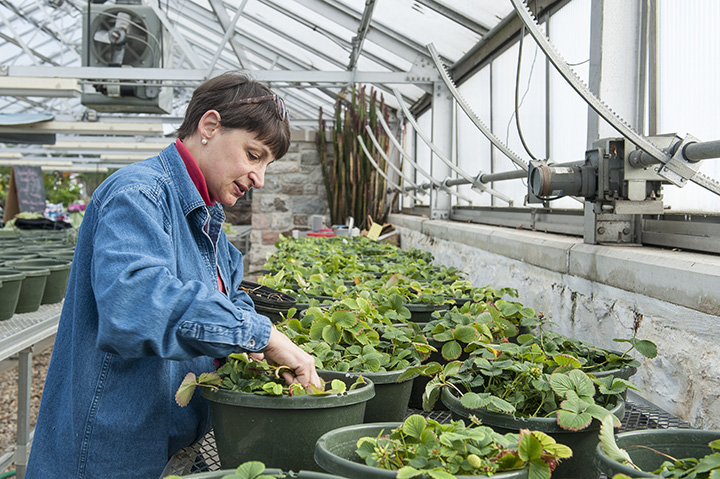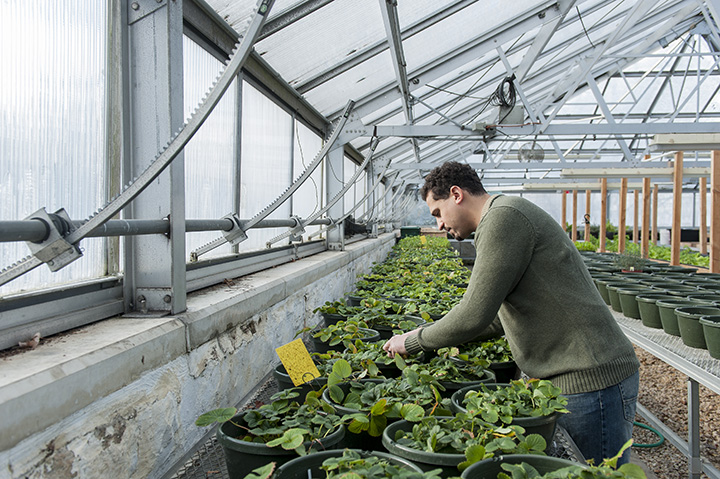On the morning after a heavy snowfall,bright sunlight streamed through the windows at the City of Reading Greenhouse. Inside, urban farmer Brian Twyman turned on jazz music, creating a soothing backdrop for the volunteers who were tending to rows of crops.
Twyman, his waist-length dreads pulled into a floppy ponytail and his sleeves rolled up to his elbows, walked to the back of the room to check on some of the greenhouse’s hardest workers–dozens of worms layered in a large compost container. “Eat up,” he said while dumping waste, including used coffee grounds from the Downtown Reading restaurant Mi Casa Su Casa, on top of them.
The worms’ castings will soon be used to create Reading Roots Urban Farm’s nutrient-rich potting soil, made without any pesticides, chemicals or additives. Plants, herbs and vegetables will grow in the soil, proving that farming isn’t limited to just rural parts of the map.
In less than three years, Permacultivate, the non-profit that operates the greenhouse, has taken root in Reading. Headed by Twyman (the self-described idea guy) and Eron Lloyd (the self-described policy guy), the organization is at the forefront of local urban farming and sustainable agriculture, particularly using the methods to improve the city’s economy, food infrastructure, aesthetics and community development.
“I’m so happy when I’m here,” says Twyman, vice president of Permacultivate. “I see this, and I know we’re doing something that benefits the community. We’re doing something people said couldn’t be done. But look around; it’s amazing. Plants are growing; people are getting their hands dirty; kids are helping out. Now we just need to make it work on a larger scale. We’re ready to rock.”
Urban farming was commonplace generations ago, says Lori Kaplan of Reading, a Permacultivate board member and volunteer who describes herself as “the old gardener in the group.” Families would utilize small plots of land in their back yards, or even on windowsills, to grow fruits, vegetables and herbs.
However, the craft was rarely passed down. Factor in fast food, microwave meals and technology, and we’re left with a culture in which many people, especially city dwellers, aren’t familiar with farming or how their food is produced, she says.

Aside from watching his mother bake zucchini bread with fresh ingredients from her garden, Twyman says he knew little about agriculture before he began experimenting with container gardening in 2005. He used assorted pots in his Reading back yard to grow lettuce, peppers, kale and collard greens. That led to an interest in community gardening, through which he and others turned several vacant city lots into vibrant gardens.
“Grow what you can, where you can, whenever you can,” Twyman says. “You can do it, even if you don’t have land. You can garden anywhere. It’s about turning nothing into something.”
“And utilizing existing resources,” Kaplan adds.
“Here we are in Reading, an old industrial town,” Twyman continues. “What are we going to do here? We are trying to show everyone that there are tons of things we can do, and at the same time, we can impact job creation, economic improvement, community development and food creation.”
Earth and Water
Permacultivate’s first major project is the Reading Roots Urban Farm and Learning Center, located in the City of Reading Greenhouse on the outskirts of City Park. There, two cutting-edge aquaponic systems are used to produce foods and perennial plants: a gravel-bed system, where river rock is used to support the plants’ roots, and a floating raft system, where the roots of cilantro, parsley and basil, among other plants, are suspended in water that’s fertilized by tilapia swimming in a nearby recycled tote.
“These are sustainable, low-cost, efficient systems,” Twyman explains. “We also have integrated pest management so we can keep food as fresh as possible without using harmful pesticides.”
In addition to experimenting with permaculture systems, Lloyd and Twyman pride themselves on forming partnerships with local businesses and organizations, Lloyd says. The group frequently works with the Reading Housing Authority, Junior League of Reading, Reading School District and Berks Conservancy. In addition, from June through October, the group sells just-harvested items like mint, strawberries and thyme at the Penn Street Market.“It’s not just about gardening. It has a purpose, too,” Twyman says. “Micro-businesses can be created because of urban farming and community partnerships. It keeps money local, it gives residents healthy foods and it helps the environment because we don’t have to ship produce thousands of miles.”
Hector Ruiz, chef-owner of Sofrito Gastro Pub in the historic Centre Park District of Reading, agrees. One of Reading Roots’ best customers, he buys 5 to 10 pounds of fresh-grown lettuce from the greenhouse each week and uses it to create his popular Urban Salad. “My long-term goal is to be as locally sustainable as possible,” Ruiz says. “We want to work together like businesses used to do. We need to support each other. I’m happy to promote their organization by using their product. As Permacultivate grows, we hope to grow with them.”
Grow it here, there, anywhere
Back at the greenhouse, Phil Wert of West Reading hoisted his 2-year-old daughter, Naomi, high enough to pluck a cherry tomato right off the vine. Tomato juice dripping down her fingers and shirt, she reached out for another, then another. Her dad obliged, and smiled. Naomi didn’t know it, but her mid-morning snack, grown to perfection through the greenhouse’s rock-bed aquaponic system, was literally the fruit of her father’s labor.
“For her, I want her to see that you can grow food not only locally, but also in an urban environment,” says Wert, a member of Permacultivate’s board of directors and an active volunteer at the greenhouse. “I know we’re going in the right direction. I know we’re doing what’s right. These are not new ideas. We just need to take action, and we’re doing that.”
Twyman shakes his head in agreement.
“There is no one else doing what we’re doing here. It’s another beautiful thing in the city,” he says. “We want to help change the city and make it a place where people want to come. Look at what beauty we have right here. Despite naysayers, we’re making changes for the better.”
“We’re not done,” he adds, smiling. “We want to do so much more.”
























BY KRISTIN BOYD | PHOTOS BY MIKE NOBLE
















